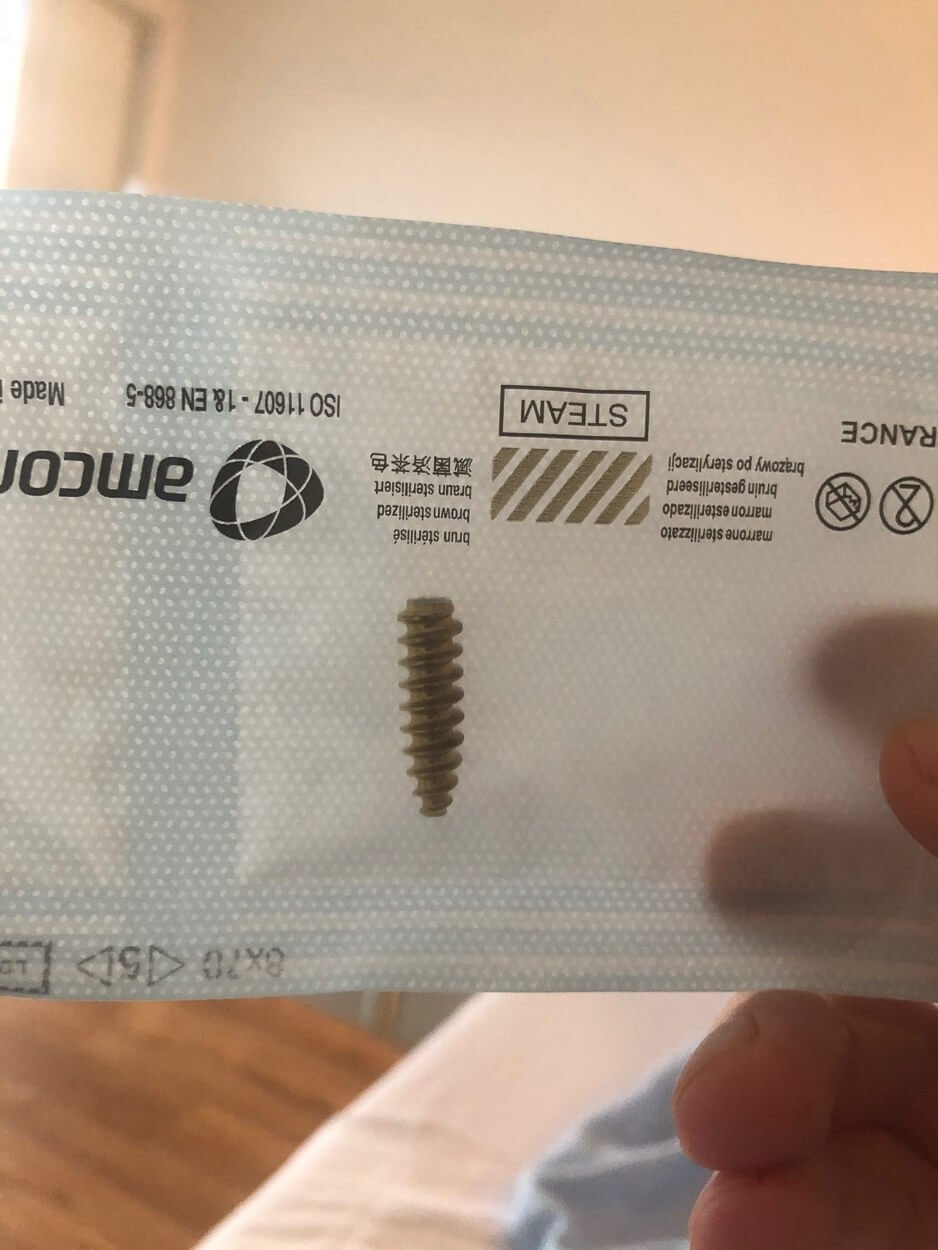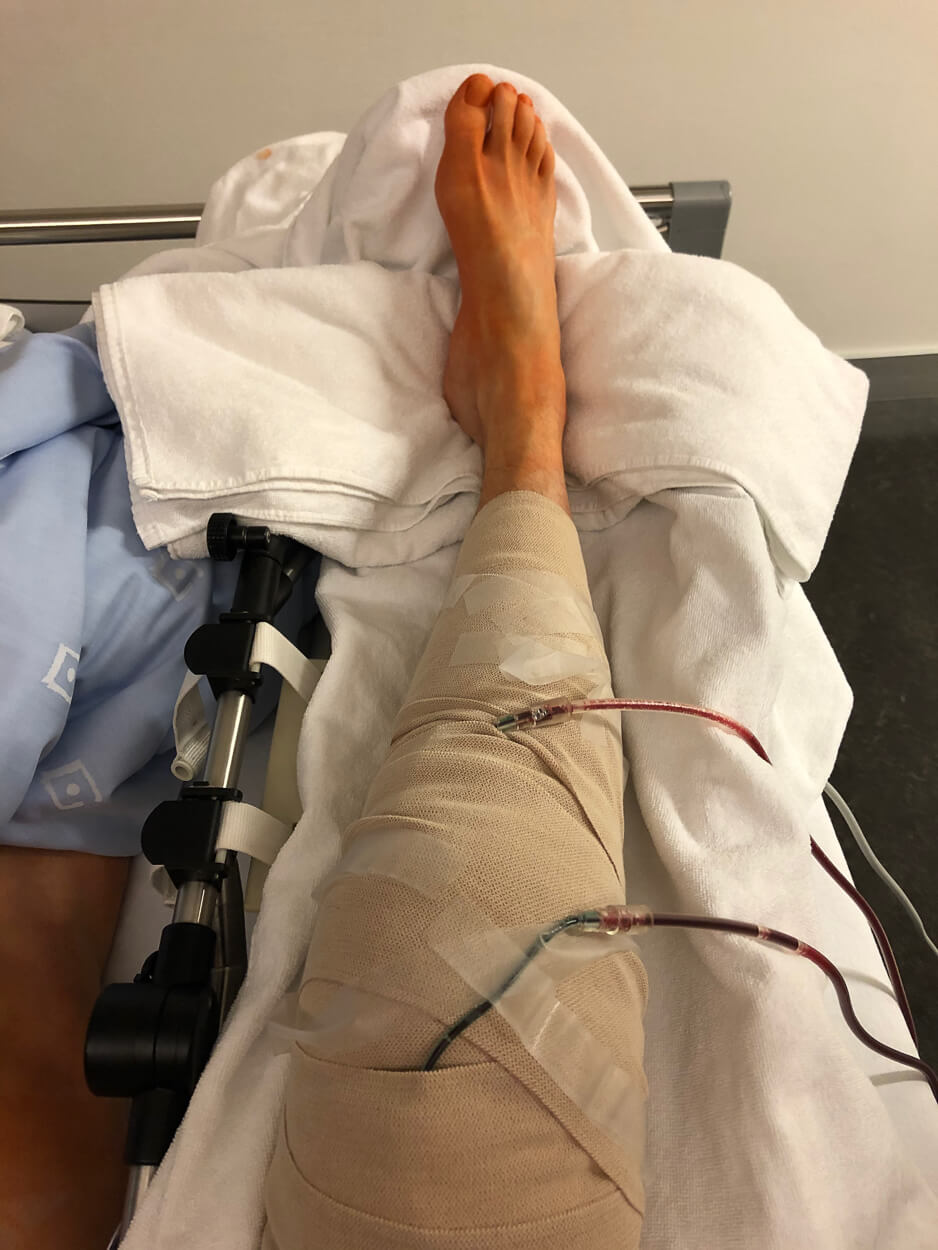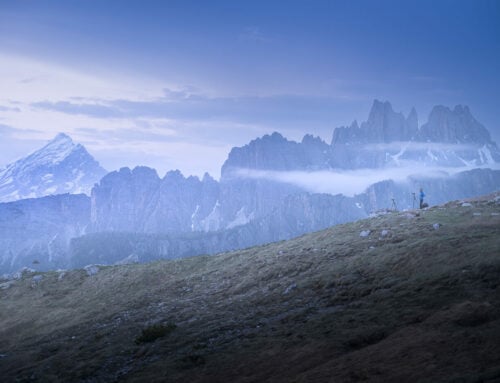Hiking after ACL Surgery
If you landed on this page, chances are you’re waiting for your ACL surgery, recovering from it, or wondering what hiking will be like afterward. If that’s the case, I wish you all the best. There’s a long road to recovery ahead. I tore my right knee’s anterior cruciate ligament twice, once with meniscus damage. Unfortunately, I am all too familiar with the surgery, the recovery process, and how painful both can be.

On the hospital bed, after surgery.
After my second injury, I spent almost five months living on a couch, only getting up to attend physiotherapy sessions three times a week and do my exercises at home, as I couldn’t put much weight on the injured leg for a while. Recovery is tough, with many ups and downs, but there is an end, no matter how distant it may seem.
And, as you can probably tell from the main topic of this website, I fully recovered and am now hiking even more than before. It took me about eight months to return to my normal hiking routine. Thanks to intense post-surgery therapy and ongoing training, my injured leg and knee are actually stronger than before. Still, I often feel like the knee is at the back of my mind with every step I take.
However, I will share my experience with ACL injuries and the complete recovery process, along with recommendations on what to watch out for if you’ve suffered the same injury and are at any stage of healing.
Table of Contents
My ACL Injuries
As you may be well aware, the pain of a full ACL/Ligament tear is something you will remember for a long time. I’ve had several injuries and broken quite a few bones, but so far, the ACL rupture was the worst physical pain I’ve ever felt. I saw the stars, literally.
The first time it happened, I was playing indoor football (soccer) and I pivoted on my right leg to turn around. I suddenly felt a snap inside the knee and fell to the floor, inventing a few new swear words in the process. Funnily enough, after the first five minutes of pain, I felt like I could keep playing. Luckily, the coach knew better and sent me back home.
The second time, I slipped while walking down the stairs. I fell with my whole weight on my bended knee, rupturing the same ACL again, plus shattering the meniscus into several different small pieces. The knee got locked, leaving me with about 20% mobility range. For some reason, I don’t think it was that bad. I thought the knee just got locked somehow, and, perhaps like a dislocated shoulder, they could put it back into place. So I was somewhat surprised when the doctors delivered the meniscus+ACL verdict. Not again, I thought.
One thing you should know is that if you ruptured your ACL once, you are more likely to rupture it again in either the same or the opposite knee than someone who has never suffered that injury (Sources 1,2).

My very own screw from the first surgery, recovered and returned to me by the doctor after the second surgery.
ACL Reconstruction Surgery and Recovery – My experiences
Before getting into that, a recommendation: if you can, choose your doctor carefully. Research doctors in your area, talk to them, and then decide where to go for surgery. Then, do everything your doctor and your therapist advise you to do.
ACL Surgery
Each time, my ligament was reconstructed using the patellar tendon. This may not always be an option if you rupture the same ligament twice, because the tendon needs time to regrow in between. Actually, the surgeon was not sure if this was possible in my case either. So they were ready to take the tendon my my healthy knee.
Luckily, this did not need to be the case, and they were able to extract enough material from the injured knee and rebuild the ligament with it. Twenty years, the time that passed between the first and second ACL injury, was enough for the patellar tendon to fully recover.
For the first ACL surgery, I chose full anesthesia, while for the second one, I chose the spinal. Personally, I find full anesthesia to be heavier on the body, meaning I feel much worse upon waking up compared to spinal anesthesia.
It’s a few days in the hospital, where therapy begins immediately with passive movements, with a CPM machine. A CPM machine (Continuous Passive Movement) is a device that is placed on the bed and moves the leg for hours on end, and helps keep the range of motion, as well as manage the swelling.

Recovery with a CPM machine the day after surgery.
Recovery from ACL Surgery
Anyway you slice it, it sucks. It’s painful, it’s seemingly endless, and sometimes you feel like you are not making any progress. Still, you have to push through. That’s what really counts. Also, you’re going to lose a lot of muscular mass, which you’ll need to work hard to recover.
The first few weeks were all about moving the knee and keeping the swelling under control. A lot of time spent with my legs up. That really helped, more than icing, which is something the doctor did not recommend in my case. The reason why the doctor did not recommend Icing was to let the blood flow through the tissue for it to heal.

Swelling will persist for a while, and keeping the leg raised helped draining it away from the knee.
Then, walking with the crutches, without putting any weight on the leg. Next, I had to gradually apply more weight to it for a few weeks. Finally, after five months, came the time to try and walk without crutches.
Basically, I had to learn to walk again. I had spent five months on a couch, doing exercises that seemed to lead nowhere, then I had to learn to stand on two feet again. However, progress from here is fast, as you will also probably increase the strength exercises.
Initially, walking for half an hour was quite a feat, but I soon managed to increase it to one hour or more.
First Hike after ACL surgery
Obviously, as soon as the therapist gave me the green light, I went on a hike. This was six months after the first surgery in November. Needless to say, I was as happy as a kid in a candy store.
I did it on a trail I was familiar with, as I did not want to worry about having to find my way around and just wanted to focus on my leg’s mobility. Going on a trail you are familiar with also means knowing where the difficult and potentially dangerous areas are, so you are less likely to find surprises on the way.
The hike was about a 14 km round trip with a 994m elevation gain. I was actually surprised I could manage that much. I initially planned to do only 8KM with half of the elevation gain, but once I arrived at the destination, I felt great and not in my legs at all, so I decided to push further.
Needless to say, I was dead tired, but happy. I think I slept with a smile all night.

Photo from my first hike after ACL surgery. A relatively long hike with easy terrain.
Recovery and Return to Hiking
Gradually, and within a couple of months, I returned to my usual hiking schedule. Somehow, my legs seem to have kept their “hiking memory”. By that, I mean the leg movements felt like they could go on forever. However, my cardio and endurance weren’t really up to speed yet.
For the first couple of months, even if the legs felt like they could take on longer hikes, I returned from each hike dreadfully tired and almost exhausted. I would guess that may be because the physio focused on movement, leg strength, and balance/proprioception, but not really on cardio fitness.
So even if the legs feel like they could keep going, I’d recommend not pushing it too much at the beginning. Start with shorter hikes and finish them even when you feel like you could keep going. See how recovery and tiredness are for the next couple of days and adjust efforts accordingly.
Overall, I would say it took me two and a half months from the first short hike after my ACL injury to be back in my regular hiking routine, which means 20-25km day hikes with anywhere between 1,000 to 2,000m elevation gain.
The most challenging post-ACL recovery aspect when hiking
However, even when I felt like I was fully recovered, a few things stuck with me for a while.
When I found the most challenging, when returning to hiking as I did before the injury, was using my legs in a balanced way. By that I mean that despite my efforts not to, I kept using my “healthy” leg more than the injured one. Whether going uphill or downhill, most of the weight was always on my healthy leg.
This is not something I was doing intentionally, though. I did put my best effort into using both legs equally. Still, I wasn’t. How did I know? The “healthy” leg was constantly more sore a day or two after each hike.
That is something I would warn anyone to pay attention to from the early stages, as I am not sure putting too much weight on the “healthy” knee would be good for it in the long run. Make sure you talk about that with your therapist if you’re concerned about that or notice the same.
It took me about three years for that to disappear in my case.
Keep working on your leg strength
My tip would be to always practice caution. Keep training and keep your legs strong. If you are a hiker, think twice and then think again about every slippery, narrow, or scrambling passage. Think about the safest and best way to protect your knee above all.
If you’ve had an ACL injury, statistically, you are more likely to have a second injury in the same or opposite knee, as I mentioned above.. Don’t make the error of thinking that because you’ve just injured your knee, another ACL injury won’t occur anytime soon or ever.
So, how does the knee feel after ACL surgery and months or years of hiking afterwards?
I am not sure about others, but in my case, despite a full recovery, the knee never felt the same. The knee does feel good and stable, especially as I keep exercising. Still, the feeling that something is different is always there.
It could easily be just a thing in my mind, and it probably is. It is a very painful injury and a very long and painful recovery after all. Perhaps it’s just a way my body tells me to be alert, but in the end, the feeling that “the knee isn’t the same” is always there in the back of my mind.
Also, I completely gave up twist-and-turn or stop-and-go sports. I know that won’t necessarily save me from another injury, but after two, I don’t want to push my luck. I have plenty to do anyway, between hiking, road cycling, gravel cycling, snowshoeing, snowboarding, and the occasional run, time is never enough.
As for hiking, it’s now five years after my second injury, and from the year after that, I regularly hiked more than 700km each year. So, however long the recovery process may feel, there’s an end to it. Hang in there.
Additional Resources
Planning future trips and hikes is one of the activities that helped and motivated me to keep up with the exercises I much as I could.
Since you are here, you might as well discover hiking trails in some of my favourite destinations!






Leave A Comment